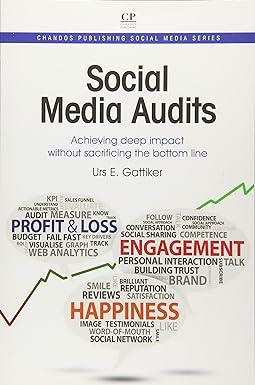Question
Need Help to solve solution to each multiple choice question as follow: 1. Which of the following is a fundamental character trait that a CPA
Need Help to solve solution to each multiple choice question as follow:
1. Which of the following is a fundamental character trait that a CPA should possess to help withstand client and competitive pressures to act unethically:
Virtues Morals
Integritiy
Norms
Values
2.The basic ethic that guides virtually all of the worlds religions is
The teachings in the religious texts
The Golden Rule A fear of God
Empathy
Honesty
3. Ethics deals with well based standards of
Law
Discipline
Religious beliefs
How people actually act
How people ought to act
4. Your textbook states that ethics is about how we act when
We know we were being observed
We think we may be observed
No one is looking
Our peers will know what weve done
We will have to testify under oath as to what we have done
5. The Josephson Institute of Ethics identifies Six Pillars of Character that provide a foundation to guide ethical decision making. These ethical values include
Trustworthiness, honesty, integrity, reliability, loyalty, and whistleblowing
Trustworthiness, respect, responsibility, fairness, caring, and citizenship
Trustworthiness, honesty, integrity, reliability, loyalty, and respect
Trustworthiness, honesty, integrity, reliability, respect, and responsibility
None of the above
6. Kohlberg developed his theory of six stages of moral development by using data from studies on how decisions are made by individuals. He concluded that the highest claim of morality is
The universal principle of justice and equality as examples of principles that are deemed universal
Behavior emphasizing the morality of law and duty to the social order
An individual who is motivated by upholding the basic rights, values, and legal contracts of society
What is right is judged by ones obedience to rules and authority
An individual who is not only motivated by rules but seeks to do what is in the perceived best interests of others
7. In the Ford Pinto Discussion Question, we discussed whether Ford made a good business decision. What does your instructor believe the answer is to this question?
The decision was a good business decision because it complied with requirements from the National Highway Traffic Safety Administration
The decision was a good business decision because it complied with a court case, United States v. Carroll Towing
The decision was a good business decision because it would have cost more to fix the problem than the projected financial losses caused by the problem
All of the above are true and support it being a good business decision
A decision that is not ethical can never be a good business decision.
8. Your textbook states that in the Pinto case, Fords risk-benefit analysis relied only on
Act-utilitarian reasoning
Rule-utilitarian reasoning
Egoism Enlightened egoism Return on Investment (ROI) logic
9 The Ethical Dissonance Model describes differences in organizational ethics and individual ethics. If you are an individual in an organization with a Low-High fit, what should you most likely do?
Do all that you can to stay employed at this company because it is likely to bring you job satisfaction
This is a good fit for you, but one that is likely to bring the organization and your career to an unhappy ending
Find another job because you will not be able to meet the high ethical standards set by this organization
Find another job because you likely will not be happy working for this organization and may find it to be harmful to your career
None of the above
10. To avoid plagiarizing, if you use an authors specific word or words
All you need to do is credit the source at the end of the paper or somewhere in the paper
All you need to do is place those words within quotation marks
You must place those words within quotation marks and you must credit the source
You can avoid plagiarizing by paraphrasing the authors words rather than using specific words, in which case, you dont need to use quotation marks nor credit the source
None of the above
Step by Step Solution
There are 3 Steps involved in it
Step: 1

Get Instant Access to Expert-Tailored Solutions
See step-by-step solutions with expert insights and AI powered tools for academic success
Step: 2

Step: 3

Ace Your Homework with AI
Get the answers you need in no time with our AI-driven, step-by-step assistance
Get Started


